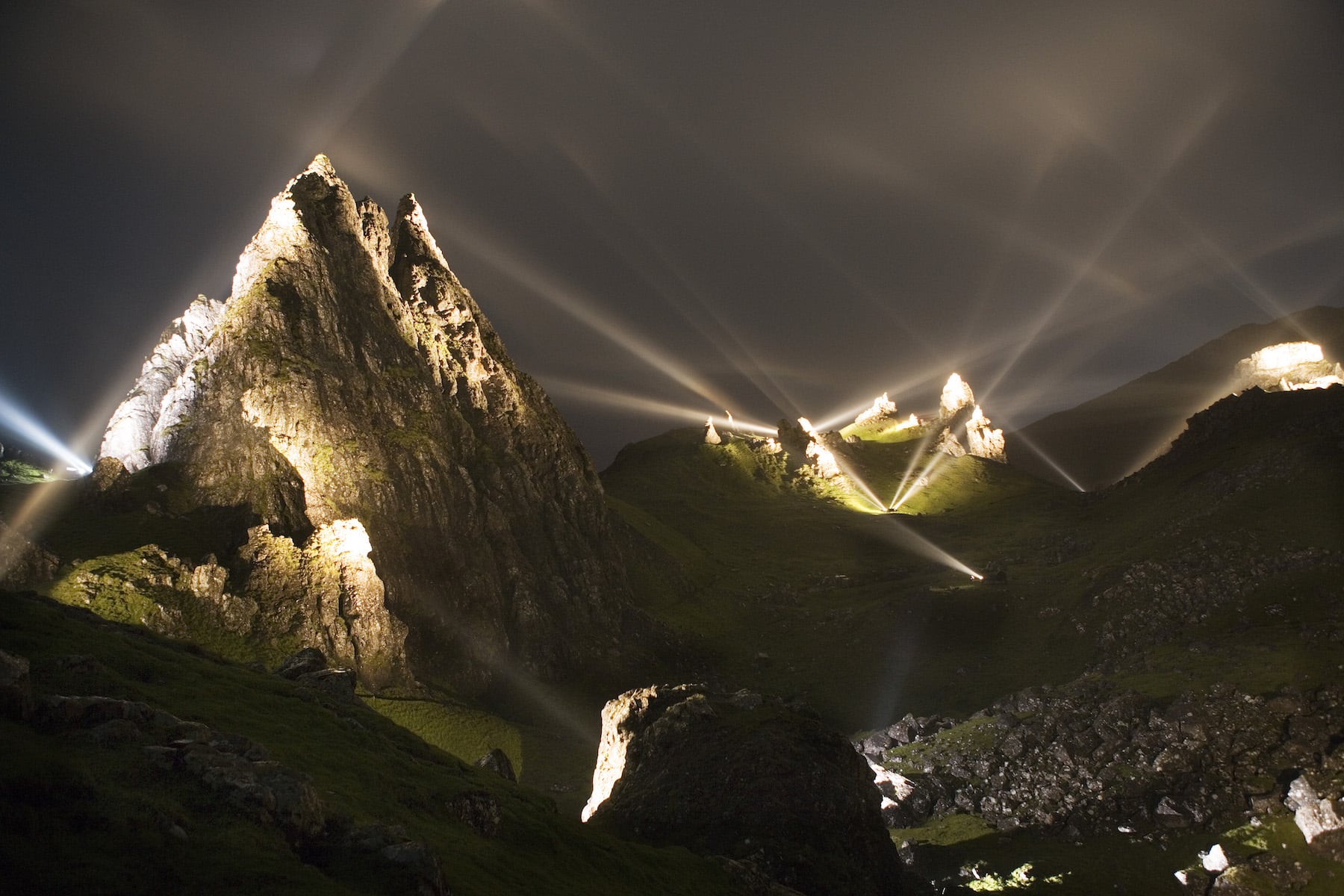The Old Man Welcomes You
Tha am Bodach a’ Cur Fàilte Ort
Welcome to the Old Man of Storr, situated on the Isle of Skye in the Highlands of Scotland. Gaelic is spoken on the Isle of Skye and is an important part of the culture. The Old Man of Storr translates to Bodach an Stòir in Gaelic. When the weather is clear, the iconic landmark can be seen from miles around and is a renowned symbol of Scotland.
Created by an ancient landslip, the rock face and pinnacles were formed millions of years ago, when dinosaurs roamed the land. Legend varies around the ‘Old Man’, with some locals believing that the pinnacle is the thumb of a giant who is now buried underground, whilst others declare that the face of an old man can be seen in the rock face. Which do you think it is?
Fàilte gu Bodach an Stòir, suidhichte san Eilean Sgitheanach ann an Gàidhealtachd na h-Alba. Tha a’ Ghàidhlig air a bruidhinn san Eilean Sgitheanach agus tha i na pàirt chudromach dhen chultar. Nuair a tha sìde shoilleir ann, chithear an comharra-tìre cliùiteach seo bho iomadh mìle mun cuairt agus e na shàmhla ainmeil air Alba.
Air an cruthachadh le maoim-slèibhe àrsaidh, chaidh aghaidh na creige agus na binneanan a chumadh o chionn milleanan bliadhna, nuair a bha dìneasairean a’ siubhal na talmhainn. Tha grunn sgeulachdan co-cheangailte ris a’ Bhodach, le cuid de mhuinntir an àite a’ creidsinn gur e òrdag fuamhaire a tha a-nis air a thìodhlacadh fon talamh a tha sa bhinnean, agus cuid eile dhen bheachd gum faicear aodann seann duine ann an aghaidh na creige. Dè tha thu fhèin a’ smaoineachadh?
See for yourself
Faic Dhut Fhèin
Flora and Fauna
Lusan is Ainmhidhean
We have rich biodiversity on the Isle of Skye and at the Old Man of Storr, which includes various wildlife species and plants. It is important we protect our biodiversity as it makes up an important part of our ecosystem along with geodiversity. The more diverse an ecosystem is, the greater resilience and adaptability it has to climate change. In 2020, the Scottish Government proposed a strategy to stop biodiversity loss by 2030 and to have restored and regenerated biodiversity across land and sea by 2045.
Tha bith-iomadachd bheairteach againn san Eilean Sgitheanach agus aig Bodach an Stòir, a’ gabhail a-steach diofar ghnèithean de dh’fhiadh-bheatha is de lusan. Tha e cudromach gum bi sinn a’ dìon na bith-iomadachd againn seach gu bheil i na pàirt chudromach dhen eag-shiostam againn, cuide ri geò-iomadachd. Mar as eadar-mheasgte a tha eag-shiostam sam bith, ’s ann as tapaidhe a tha e agus ’s ann as fheàrr a fhreagras e air atharrachadh gnàth-shìde. Ann an 2020, mhol Riaghaltas na h-Alba ro-innleachd gus stad a chur air call bith-iomadachd ro 2030 agus gus bith-iomadachd ath-stèidheachadh is ath-bheothachadh thar muir is tìr ro 2045.
Ready for adventure
Deiseil airson dànachd
Working Together
Ag Obrachadh Còmhla
The Old Man of Storr site is run by The Highland Council in collaboration with our partners at the Skye Iconic Sites Project (SISP); SkyeConnect, NatureScot, Outdoor Access Trust for Scotland (OATS), Scottish Government Rural Payments & Inspection Directorate (SGRPID), Staffin Community Trust, and the Minginish Community Hall Association (MCHA).
Tha làrach Bodach an Stòir air a ruith le Comhairle na Gàidhealtachd ann an co-bhann leis na com-pàirtichean againn aig Pròiseact Làraich Ìomhaigheach an Eilein Sgitheanaich: SkyeConnect, NàdarAlba, Urras Cothrom air a’ Bhlàr A-muigh an Alba, Buidheann-stiùiridh Pàighidhean Dùthchail is Sgrùdaidhean Riaghaltas na h-Alba, Urras an Taobh Sear, agus Comann Talla Coimhearsnachd Mhinginis.
Unfolding Landscape 2005
Cruth-tìre a’ Fuasgladh 2005

Image: Euan Miles
NVA’s mission was to make powerful public art that reaffirms people’s connection to the built and natural heritage.
The company, led by Angus Farquhar, produced many unusual and dynamic interventions in extraordinary landscapes over 20 years – light, sound, and collective movement were incorporated into the mountains of Skye, city lighting festivals, and international cultural events including the 2012 Olympics and the Tour de France – Grand Depart in Yorkshire in 2014.
Their practice used creative learning and environmental innovation, involving audiences in physically redefining urban and rural settings, revealing how places shape and are shaped by people.
NVA is an acronym of ‘nacionale vita activa’, expressing the Ancient Greek ideal of a lively democracy, where actions and words shared among equals bring new thinking into the world.
For 42 nights, NVA engaged with and animated the dramatic natural land formation of The Old Man of Storr in Trotternish on the Isle of Skye. Forty epic light and sound installations brought an audience of 6,500 people, equipped with headlamps, guides and walking sticks, who took part in a strenuous climb and descent to witness one of Europe’s most inspiring land and seascapes in the dead of night. The massed pinnacles and buttresses at an altitude of 1,400 feet were illuminated while powerful soundscapes drifted down from the ridges above.
The entire exercise was achieved without the use of any oil burning fuel or generator emissions, a world first in the history of outdoor public art and events set in a rural location.
The Storr featured new sound commissions by Skye based composer Paul Mounsey and Geir Jenssen from Tromso, north Norway and included archive voice recordings of Raasay’s great poet Sorley MacLean. Anne Martin’s resonant live singing drawn from the legendary north island song tradition was heard eerily echoing among the upper cliffs and drifting down through the forest.
The Storr: Unfolding Landscape created an intense and personal experience for each walker, with the dynamics of the weather leading to varied reactions. Alex Rigg performed one of the great solo dance efforts of all time with 41 repeated performances of a solo choreography set beneath the 800 feet Storr cliffs.
The Storr was David Bryant’s last great work as he died within a year. He won Lighting Designer of the Year and spent 2 years fighting to be well enough to make it out onto the Trotternish slopes and deliver his finest work. He is still missed to this day and was one of the most creative, courageous and inventive lighting practitioners the world has known.
“…It really did feel as if we were looking at something happening in another world, heaven perhaps” Observer
Click here for more information, images, and film.
B’ e rùn NVA ealain phoblach chumhachdach a dhèanamh a tha ag ath-dhaingneachadh ceangal dhaoine ris an àrainneachd thogte is nàdarrach.
Rinn a’ chompanaidh, a tha air a stiùireadh le Angus Farquhar, iomadh eadar-theachd annasach is fiùghantach ann an cruthan-tìre iongantach thar 20 bliadhna – chaidh solas, fuaim, is co-ghluasad a thoirt an lùib bheanntan an Eilein Sgitheanaich, fèisean solais ann am bailtean mòra, agus tachartasan cultarach eadar-nàiseanta a leithid Gheamannan Oilimpeach 2012 agus an Tour de France – Grand Depart ann an Siorrachd Iorc ann an 2014.
Bhiodh iad a’ cleachdadh ionnsachadh cruthachail agus ùr-ghnàthachas àrainneachail, a’ toirt luchd-èisteachd an lùib a bhith a’ toirt ath-mhìneachadh corporra air suidheachaidhean bailtean is dùthchail, a’ toirt am follais mar a bhios àiteachan a’ cumadh dhaoine agus air an cumadh le daoine.
’S e acronaim de ‘nacionale vita activa’ a th’ ann an NVA, a’ cur an cèill sàr-bheachd nan Greugach Àrsaidh de dheamocrasaidh beothail, far a bheil gnìomhan is faclan a tha air an co-roinn am measg dhaoine co-ionann a’ toirt smaoineachadh ùr dhan t-saoghal.
Airson 42 oidhche, thug NVA com-pàirteachadh is beòthalachd gu cruth-tìre nàdarrach dràmadach Bodach an Stòir ann an Tròndairnis san Eilean Sgitheanach. Chaidh dà fhichead stàladh iongantach solais is fuaim a chur air dòigh agus thàinig 6,500 neach-èisteachd is iad air an uidheamachadh le lampaichean-cinn, leabhrain-iùil is bataichean, airson pàirt a ghabhail ann an dìreadh is cromadh saothrachail airson fear de na cruthan tìre is mara as brosnachaile san Roinn Eòrpa fhaicinn ann am marbhan na h-oidhche. Bha na binneanan is na stùcan uile aig àirde 1,400 troigh air an soillseachadh fhad ’s a bha cruthan-fuaime cumhachdach a’ sileadh a-nuas bho na dromannan os an cionn.
Chaidh seo uile a choileanadh gun a bhith a’ cleachdadh connadh sam bith a bha a’ losgadh ola no a’ cruthachadh sgaoilidhean sam bith. B’ e seo a’ chiad turas a chaidh seo a dhèanamh le ealain is tachartasan poblach air a’ bhlàr a-muigh ann an suidheachadh dùthchail.
Bha coimiseanan fuaime ùra aig an Stòr bhon sgrìobhaiche-ciùil Paul Mounsey a tha stèidhichte san Eilean Sgitheanach agus bho Geir Jenssen à Tromso, ann an ceann a tuath Nirribhidh, agus bha clàraidhean tasglainn ann de ghuth Shomhairle MhicGill-Eain, an sàr bhàrd à Ratharsair. Bha an t-seinn ghlòrach bheò aig Anna Mhàrtainn, bho dhualchas òran ceann a tuath an eilein, a’ dèanamh mac-talla uaignidh am measg nam bearraidhean àrda agus a’ sgaoileadh a-nuas tron choille.
Chruthaich An Stòr: Cruth-tìre a’ Fuasgladh turas dian is pearsanta do gach coisiche, agus bha an t-sìde chaochlaideach a’ cur ris a’ mheasgachadh de bheachdan. Rinn Alex Rigg dannsa aon-neach nach fhacas a leithid riamh, le 41 taisbeanadh air an dèanamh a-rithist is a-rithist ann an coireògrafachd aon-neach fo bhearraidhean 800 troigh an Stòir.
B’ e An Stòr an t-sàr-obair mu dheireadh aig David Bryant oir chaochail e taobh a-staigh bliadhna. Bhuannaich e Dealbhadair Soillseachaidh na Bliadhna agus chuir e seachad dà bhliadhna a’ strì gu bhith fallain gu leòr airson faighinn a-mach gu ruige Tròndairnis agus an obair a b’ fheàrr aige a lìbhrigeadh. Tha ionndrainn mhòr air chun an latha an-diugh agus bha e am measg an luchd-soillseachaidh a bu chruthachaile, a bu mhisneachaile agus a b’ innleachdaiche a bha riamh ann.
“…Bha e dha-rìribh mar gum biomaid a’ coimhead air rudeigin a’ tachairt ann an saoghal eile, nèamh math dh’fhaodte” Observer
Cliogaibh an seo airson tuilleadh fiosrachaidh, ìomhaighean, agus film.

